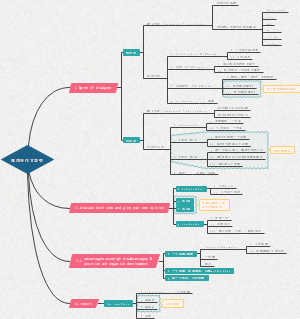导图社区 英语作业
- 137
- 4
- 2
- 举报
英语作业
这是一篇关于英语作业的思维导图,主要内容有Functions、Structure、Language techniques。
编辑于2022-10-08 12:25:13 北京市- 英语作业
- 相似推荐
- 大纲
Introduction
Functions
Structure
Funnel-shape
CARS Model
Establishing a research territory
General background
Definition
Short definition
Tea [Camellia sinensis (L.) O. Kuntze] is a beverage crop in the world .
Sentence definition
Light is an environmental factor that has an important impact on plant growth and development.
Extended definition
Light-emitting diodes (LEDs) are the main light sources in plant factories. LEDs have the characteristics of small size, light weight, long life, high light efficiency and low energy consumption.
Citation
Approaches
Direct citation
In a study of de-rooted Picea abies seedlings, red light promoted the formation of adventitious roots (Alallaq et al, 2020).
Paraphrasing
Replacing keywords with synonyms
Our results indicate that use of blue LEDs to irradiate basil cuttings significantly reduced the time required for both root formation and the development of conventional cuttings compared to other light types. For example, Lim and Eom (2013) showed that irradiation of Ocimum bacilicum cuttings with blue LEDs can significantly shorten the root development time compared to red LEDs and natural sunlight.
Changing word class
Also, it provides wavelengths (light quality) that match the spectral range required for plant growth (Massa et al, 2008; Yen and Chung, 2009).
Changing word order and sentence
Tea, one of the world’s most important beverage crops. Tea [Camellia sinensis (L.) O. Kuntze] is a beverage crop in the world
Summary
Numerous studies have shown that light quality, light intensity, and photoperiod have extensive regulatory effects on plant morphogenesis, physiological metabolism, growth and development and nutritional quality (Anderson, 1999; Ward et al, 2005; Qian and Kubota, 2009; Pérez-Balibrea et al, 2010).
Patterns
Information prominent
Other studies reported that blue light stimulated root formation in Betula pendula (Sæbø et al, 1995) and Chrysanthemum (Chan et al, 2020) cuttings.
Writer prominent
For example, Lim and Eom (2013) showed that irradiation of Ocimum bacilicum cuttings with blue LEDs can significantly shorten the root development time compared to red LEDs and natural sunlight.
Tenses
Simple past
In a study of de-rooted Picea abies seedlings, red light promoted the formation of adventitious roots (Alallaq et al, 2020).
Present perfect
Numerous studies have shown that light quality, light intensity, and photoperiod have extensive regulatory effects on plant morphogenesis, physiological metabolism, growth and development and nutritional quality (Anderson, 1999; Ward et al, 2005; Qian and Kubota, 2009; Pérez-Balibrea et al, 2010).
Simple present
Also, it provides wavelengths (light quality) that match the spectral range required for plant growth (Massa et al, 2008; Yen and Chung, 2009).
Establishing a niche
Critical literature review
Four methods
Counter-claiming
Although short cuttings have the advantages of large propagation coefficient and good characters, most short cuttings are carried out under natural conditions, which have the disadvantages of long seedling raising cycle and slow emergence speed.
Indicating a gap
In addition, there are relatively few reports on the effects of light quality on the growth and development of tea plants.
Raising a question
The underlying mechanism of the effects of different light quality on the growth and development of tea plants is still unclear.
Continuing a tradition
In addition, LEDs are “cold light sources, ” which will not attract some pests that like light and heat, and also help to reduce plant diseases and insect pests. Therefore, LEDs were chosen as the light source for this experiment.
Typical negative markers
It was found that the adventitious root formation was the best under blue light compared with white light, while the adventitious root formation was the worst under red light.
Occupying the niche
Purposes or nature of the research
Accelerating the formation of adventitious roots is very important for the “rapid seedling” of tea plants.
Research questions or hypotheses
Therefore, we first performed transcriptome and hormonal analysis of mature leaves under white, red, and blue light, and then used weighted gene coexpression network analysis (WGCNA) to identify co-expressed gene modules and hub genes for adventitious root formation.
Research value
Using modal auxiliaries
This study will provide a new idea for the “rapid seedling” of tea plants.
Outline of the paper
Therefore, we first performed transcriptome and hormonal analysis of mature leaves under white, red, and blue light, and then used weighted gene coexpression network analysis (WGCNA) to identify co-expressed gene modules and hub genes for adventitious root formation.
Language techniques
Information flow
Light is not only (an energy source for plant photosynthesis, but also a regulator of plant physiological activity).









